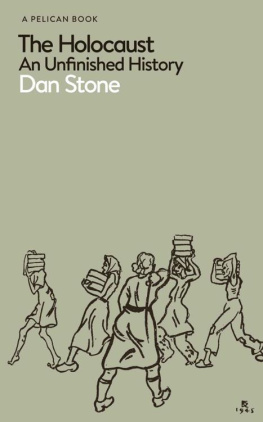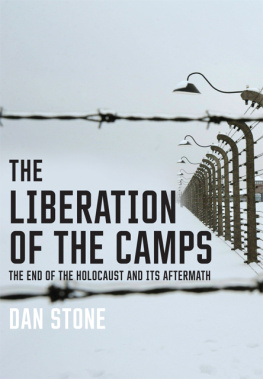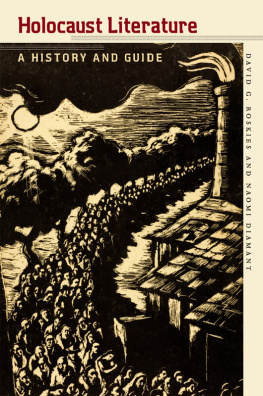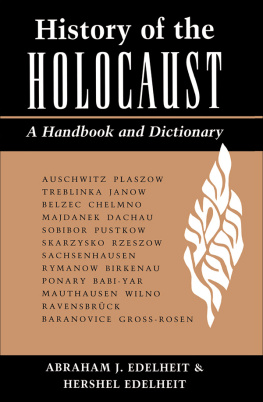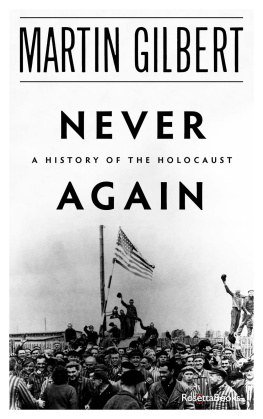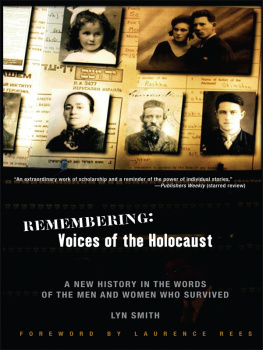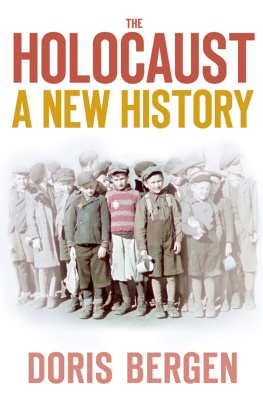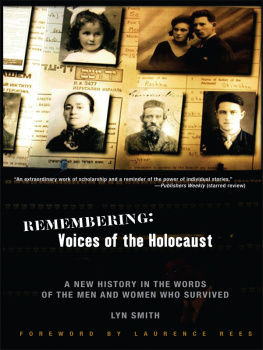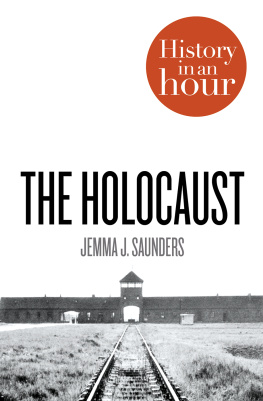Dan Stone - The Holocaust: An Unfinished History
Here you can read online Dan Stone - The Holocaust: An Unfinished History full text of the book (entire story) in english for free. Download pdf and epub, get meaning, cover and reviews about this ebook. year: 2023, publisher: Penguin Books Ltd, genre: Politics. Description of the work, (preface) as well as reviews are available. Best literature library LitArk.com created for fans of good reading and offers a wide selection of genres:
Romance novel
Science fiction
Adventure
Detective
Science
History
Home and family
Prose
Art
Politics
Computer
Non-fiction
Religion
Business
Children
Humor
Choose a favorite category and find really read worthwhile books. Enjoy immersion in the world of imagination, feel the emotions of the characters or learn something new for yourself, make an fascinating discovery.
The Holocaust: An Unfinished History: summary, description and annotation
We offer to read an annotation, description, summary or preface (depends on what the author of the book "The Holocaust: An Unfinished History" wrote himself). If you haven't found the necessary information about the book — write in the comments, we will try to find it.
Dan Stone: author's other books
Who wrote The Holocaust: An Unfinished History? Find out the surname, the name of the author of the book and a list of all author's works by series.
The Holocaust: An Unfinished History — read online for free the complete book (whole text) full work
Below is the text of the book, divided by pages. System saving the place of the last page read, allows you to conveniently read the book "The Holocaust: An Unfinished History" online for free, without having to search again every time where you left off. Put a bookmark, and you can go to the page where you finished reading at any time.
Font size:
Interval:
Bookmark:

Dan Stone is Professor of Modern History and Director of the Holocaust Research Institute at Royal Holloway, University of London. He is the author or editor of numerous academic articles and books, including Histories of the Holocaust and The Liberation of the Camps.
An Unfinished History

- CHAPTER 1 :
Before the Holocaust - CHAPTER 2 :
Attack on the Jews, 19338 - CHAPTER 3 :
Before the Final Solution - CHAPTER 4 :
War of Annihilation - CHAPTER 5 :
A Continent-wide Crime - CHAPTER 6 :
Camps and the Mobile Holocaust - CHAPTER 7 :
Great Is the Wrath: Liberation and Its Aftermath - CHAPTER 8 :
Holocaust Memory
Image from Der Giftpilz , showing a wall poster advertising a talk by Julius Streicher.
Cartoon in the Daily Express , 17 October 1938.
An American soldier stands over the bodies of inmates of Flossenbrg shot in a forest near Neunburg vorm Wald, 29 April 1945.
Europe, 1942.
Romanian deportations to Transnistria, 19412.
Romanian participation in massacres, 19412.
The death marches, JanuaryMay 1945.
Death marches to Bergen - Belsen , December 1944 to April 1945.
Major DP camps in Germany and Austria.
.
There are no clean or unclean people, at least, not in principle. There are no chosen nations. However, there are those who know of a dividing line between what is and what is not permitted, and others who not only do not know it, but who do not want to know it either.
Abel Jacob Herzberg
The program of action against the Jews included disenfranchisement, stigmatization, denial of civil rights, subjecting their persons and property to violence, deportation, enslavement, enforced labour, starvation, murder, and mass extermination. The extent to which the conspirators succeeded in their purpose can only be estimated, but the annihilation was substantially complete in many localities of Europe. Of the 9,600,000 Jews who lived in the parts of Europe under Nazi domination, it is conservatively estimated that 5,700,000 have disappeared, most of them deliberately put to death by the Nazi conspirators. Only remnants of the Jewish population of Europe remain.
From the indictment, International Military Tribunal, Nuremberg, 7 June 1946
In the diary that she kept in Bergen-Belsen, the young Jewish Yugoslav Hanna Lvy-Hass writes at one point of a boy whose body has been infested by fleas and who is rejected by his family:
[He] couldnt kill the vermin that had settled on his body because he couldnt see them; theyve burrowed deep into his skin and swarmed through his eyebrows. His chest is completely blackened by these fleas and their nests. We have never seen such a thing; we never imagined such a thing could occur Everyone avoids him. His brothers and sister dread his presence, his fleas, his howling The other night, he dragged his useless body from one bed to the other begging people to make room for him. Everyone pushed him away in disgust Painful story. His case is not unique.
This merging of animal and human, this deeply traumatic destruction of the self and the revulsion it causes amongst others who fear the same thing happening to them, is an extraordinary description. In it we glimpse the nightmarish consequences of Nazi persecution.
In one of his stories written in the d ghetto, Isaiah Spiegel describes a rabbi who, at the morning prayers, appears to go mad after being mocked by German soldiers in the street:
For a moment, Reb Bunem was paralysed, overcome by shame and nausea. The blood rushed from his heart into his hands, which began to tremble. His eyes flashed an uncanny green flame. With a surge of preternatural strength, he suddenly turned to the praying Jews and started ripping the prayer books from their hands. The frightened Jews moved off to the side while Reb Bunem continued tearing the Psalm books from their grasp and casting imprecations on their heads. He shouted with the voice of one possessed, while in the darkness of the synagogue his beet-red face glowed with divine wrath:
Jews!!! Stop reciting Psalms!!! God is on the side of our enemy! God is with the Germans! I beseech you, recite no more Psalms! Our world is shrouded in darkness!
A rabbi desecrates the holy books and pleads with his congregants to abandon their prayers.
There are still major parts of the history of the Holocaust that have not been understood in the prevailing narrative. In the region of Romanian-occupied Ukraine which the Romanians called Transnistria, Jews were herded into pigsties, where they froze to death and suffered inescapable epidemics. They were not paid for the work they did, although payment was promised. They were robbed and often tricked into handing over valuables or clothing in exchange for food that was never provided. In Acmecetca, Driven by hunger, most of the Jews were naked in a matter of weeks, covering their hips with rags or paper. The prefect, Modest Isopescu, who preferred this camp over all other camps in the Golta jude [county], inspected it a few times, each time amusing himself with the fate of the prisoners; he took pictures of the deportees grazing in the grass on their hands and knees. In Peciora, Extreme hunger quickly reduced the prisoners to eating plant roots, twigs, leaves, human excrement, and even dead bodies. Romanian and Ukrainian guards raped Jewish young women, who in turn killed themselves. Such conditions fostered mental illness and suicide.
These vignettes take us a long way from the notion of industrial murder that still prevails in the public consciousness. Even in the Nazi death camps, the perception of factory-like genocide is misleading: as we will see, even at Auschwitz the murder process was brutal and far from efficient.
The Holocaust turned the victims world upside down, not just destroying their homes and families, leaving most of the small minority of survivors unable to return to the lands of their birth, but in terms of values. Both during and after the war years, the Nazi assault on the Jews left them, in many cases, unable to lead lives guided by morality or established norms, as the above examples show. Those trapped in Nazi ghettos and camps found themselves not on another planet but certainly in the anus mundi, in which literal and metaphorical filth governed existence.
Arendts radical claim reminds us that we have in some ways either forgotten, or ignored altogether, what the Holocaust was and how devastating its effects were. The depth of the trauma caused by the Holocaust means we must move beyond a mechanistic interpretation of industrial genocide. The ubiquity of collaboration across Europe, driven by a coincidence of wants between the Nazis ideologically driven aspiration to rid the world of Jews and the desires of many nation-states leaders to create ethnically homogeneous populations, means we need to stop thinking of the Holocaust as solely a German project. It was, however, driven and largely perpetrated by Germans (including Austrians), thus we must focus on ideology, understood as a kind of phantasmagorical conspiracy theory, as the kernel of Nazi thinking and action. And finally we need to understand the ways in which the after-effects of the Holocaust shaped the postwar years and continue to be felt today.
Next pageFont size:
Interval:
Bookmark:
Similar books «The Holocaust: An Unfinished History»
Look at similar books to The Holocaust: An Unfinished History. We have selected literature similar in name and meaning in the hope of providing readers with more options to find new, interesting, not yet read works.
Discussion, reviews of the book The Holocaust: An Unfinished History and just readers' own opinions. Leave your comments, write what you think about the work, its meaning or the main characters. Specify what exactly you liked and what you didn't like, and why you think so.

